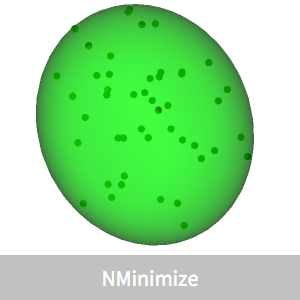Structural Optimization Problem
Find the shape of a hanging chain formed by several spring links, with a mass at each link junction.
This example demonstrates how a minimal-energy condition for equilibrium can be expressed in terms of an optimization problem with second-order cone (norm) constraints that can easily be solved with SecondOrderConeOptimization.
Find the shape of a hanging chain formed by  spring links under a vertical load at the end of each link. The objective is to find the link positions
spring links under a vertical load at the end of each link. The objective is to find the link positions  given the positions at the ends,
given the positions at the ends,  and
and  .
.
The potential energy due to gravity, neglecting the weight of the springs, is  , where
, where  is the vertical load at each end and
is the vertical load at each end and  is the standard gravity.
is the standard gravity.
The potential energy due to the tension in the spring link caused by stretching is  , where
, where  is the stretch in spring link
is the stretch in spring link  and
and  is the stiffness of the spring. Using
is the stiffness of the spring. Using  , the energy is transformed to
, the energy is transformed to  .
.
An additional constraint  must be added due to the transformation.
must be added due to the transformation.
The ends of the linked chain are clamped at positions  and
and  .
.
Because  is convex, it is sufficient to require each spring to satisfy the condition
is convex, it is sufficient to require each spring to satisfy the condition  , where
, where  is the resting length of each spring.
is the resting length of each spring.
The design parameters are as shown.
The final objective function is the sum of gravity and spring potential energy that must be minimized.
Find the end points of each of the spring links.
Visualize the shape of the resulting spring chain.
The stretch is greatest for the links near the ends of the link chain. Links 11 and 12 have the least elongation.
The solution is fast enough to manipulate the number of links and the endpoints.






















